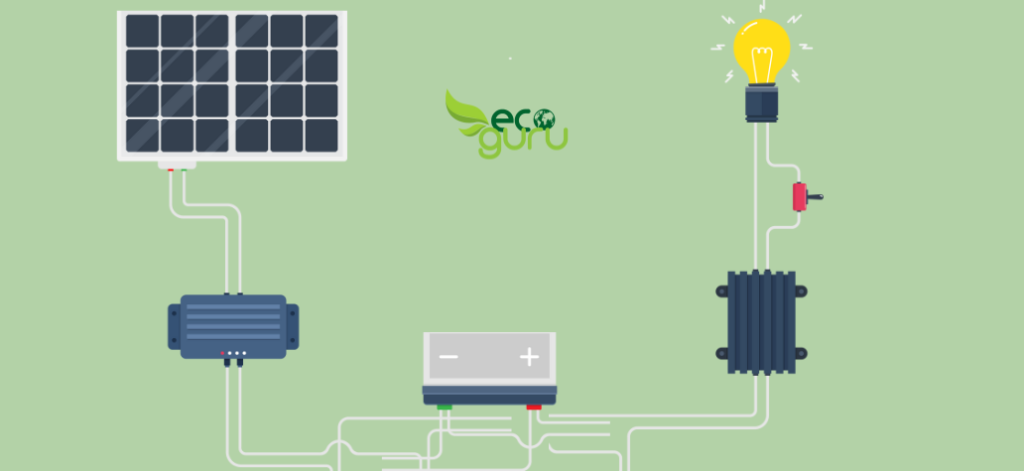Solar Energy and the Environment: A Clean Power Solution
Solar energy, often hailed as the beacon of sustainable power, is rapidly transforming the way we generate electricity. In this age of environmental consciousness, harnessing the sun’s boundless energy has emerged as a vital clean power solution. As the world grapples with pressing environmental concerns like climate change and pollution, the shift towards renewable energy sources, particularly solar power, has taken center stage.
The importance of renewable energy, especially solar energy, cannot be overstated. It not only offers a reliable alternative to fossil fuels but also plays a pivotal role in mitigating environmental issues that have plagued our planet for decades. In this blog post, we will delve into the fascinating world of solar energy, exploring how it works, its numerous benefits, and its ever-expanding presence in India.
Harnessing Solar Energy
Capturing and Converting Solar Energy into Electricity
At the heart of solar energy’s allure lies its simplicity and efficiency. Here’s how it works:
1. Solar Panels: Solar panels, also known as photovoltaic (PV) panels, are the workhorses of solar energy. These panels are equipped with solar cells that contain semiconductor materials like silicon. When sunlight, or photons, hits these solar cells, they trigger a fascinating process called the photovoltaic effect.
2. The Photovoltaic Effect: This effect is the key to converting sunlight into electricity. When photons collide with the solar cells, they excite electrons within the semiconductor material. This excitement causes electrons to break free from their normal positions, creating an electric current.
3. Inverters: The electricity generated in the form of direct current (DC) must be converted into alternating current (AC), which is what our homes and businesses use. Inverters perform this crucial role in the solar power system.
Key Components of a Solar Power System

Solar Panels: As mentioned earlier, solar panels are the primary component that captures sunlight and converts it into electricity.
Mounting Structures: These structures securely hold the solar panels in place, ensuring they receive maximum sunlight exposure.
Inverters: Inverters convert the DC electricity generated by solar panels into the AC electricity used to power our homes and appliances.
Batteries (optional): Some solar power systems include batteries to store excess energy for use during non-sunny periods or as backup power.
Net Metering System: In many cases, surplus electricity generated by your solar panels can be fed back into the grid, earning you credits or reducing your electricity bill.
Environmental Benefits

Solar Energy’s Positive Impact on the Environment
As we embark on a journey to understand solar energy’s profound impact, we cannot ignore its remarkable contribution to a cleaner and healthier environment. Here, we shed light on the environmental benefits that make solar energy a beacon of hope for a greener planet.
Reduced Greenhouse Gas Emissions
One of the most significant advantages of solar energy is its role in reducing greenhouse gas emissions. By harnessing the power of the sun, we can generate electricity without burning fossil fuels like coal or natural gas. This means that solar power systems produce electricity with zero direct emissions. In India, where air pollution is a pressing concern in many cities, this shift to cleaner energy sources has the potential to make a substantial difference in air quality and public health.
Air Pollution Reduction
The reduction of air pollution is closely tied to the decreased reliance on fossil fuels. When we burn coal or gas to produce electricity, it releases pollutants into the air, including sulfur dioxide, nitrogen oxides, and particulate matter. These pollutants contribute to smog, respiratory illnesses, and climate change. Solar energy, on the other hand, produces electricity silently and without any emissions, making it an invaluable tool in combatting air pollution.
Solar Energy in India

Current State of Solar Energy Adoption
India has been making remarkable strides in the adoption of solar energy. With an increasing focus on renewable energy sources, the nation has recognized the pivotal role that solar power plays in addressing its energy needs while safeguarding the environment. Here’s an overview of the current state of solar energy adoption in India:
1. Solar Capacity Growth: India has witnessed a substantial increase in its solar capacity over the past decade. The country’s solar power generation capacity has grown exponentially, with both government and private initiatives driving this growth.
2. Government Initiatives: The Indian government has launched ambitious schemes and incentives to promote solar energy adoption. These include the Jawaharlal Nehru National Solar Mission and various state-level policies aimed at promoting renewable energy.
3. Solar Parks: The development of solar parks and the allocation of land for solar projects have facilitated large-scale solar energy generation.
4. International Collaboration: India has collaborated with international organizations and governments to bolster its solar energy infrastructure, making it one of the fastest-growing solar markets globally.
5. Job Creation: The solar energy sector has not only contributed to cleaner energy but has also been a significant source of job creation in India.
6. Future Prospects: With an increasing emphasis on sustainability and a growing awareness of environmental issues, the future of solar energy in India looks promising. The nation is on track to achieve its ambitious renewable energy targets.
By embracing solar energy, India is not only addressing its energy needs but also paving the way for a greener and more sustainable future. The statistics and growth trends in the solar energy sector indicate that India is well on its way to becoming a global leader in renewable energy adoption. In the following sections, we will explore the advantages of using solar power for individuals and businesses, as well as the challenges and solutions associated with solar energy adoption.
Advantages of Solar Power

Solar Power for Individuals and Businesses
Solar power offers a multitude of advantages for both individuals and businesses alike. In this section, we’ll explore how embracing solar energy can positively impact your life and your bottom line.
1. Lower Electricity Bills
One of the most compelling reasons to go solar is the potential for substantial savings on your electricity bills. By harnessing the power of the sun, you can generate your own electricity, reducing or even eliminating your reliance on grid electricity. As a result, you’ll see a noticeable decrease in your monthly energy expenses. In a country like India, where electricity costs can be a significant burden on households and businesses, this financial relief is particularly enticing.
2. Energy Independence
Solar power provides a pathway to energy independence. When you generate your electricity, you become less vulnerable to fluctuations in energy prices and grid outages. This independence not only ensures a reliable power supply but also contributes to a more resilient and self-sustaining lifestyle or business operation.
3. Job Creation
The solar energy sector is a powerhouse for job creation. As India invests in solar infrastructure and projects, numerous employment opportunities emerge, spanning from manufacturing and installation to maintenance and research. Solar energy projects not only generate clean power but also contribute to the growth of the green job market.
Challenges and Solutions
Overcoming Common Challenges in Solar Energy Adoption
While the benefits of solar energy are abundant, it’s essential to acknowledge and address the challenges that individuals and businesses may encounter during the adoption process. Here, we’ll examine these challenges and present potential solutions and government initiatives aimed at smoothing the transition to solar power.
Common Challenges
1. High Initial Costs: The upfront cost of purchasing and installing solar panels can be a significant barrier for many. The initial investment required for solar equipment and installation may deter some individuals and businesses from going solar.
2. Intermittent Energy Production: Solar energy production is dependent on sunlight, which means energy generation is intermittent. Cloudy days and nighttime limit power generation, raising concerns about reliability.
3. Storage and Grid Integration: Efficient energy storage solutions and seamless integration with the existing power grid are essential for maximizing the benefits of solar power.
Solutions and Initiatives:
1. Government Subsidies and Incentives: To mitigate the high initial costs, the Indian government offers various subsidies and incentives, such as capital subsidies and net metering, to make solar installations more affordable.
2. Advancements in Energy Storage: Technological advancements in energy storage solutions, such as batteries, are enhancing the ability to store excess solar energy for use during non-sunny periods.
3. Grid Modernization: Ongoing efforts to modernize the grid are improving the integration of solar power into the existing infrastructure, ensuring a more reliable power supply.
FAQs Solar Energy and the Environment

How do solar panels work?
Solar panels work by harnessing sunlight and converting it into electricity through a process called the photovoltaic effect. When sunlight hits the solar cells within the panels, it excites electrons, creating an electric current. This current is then converted from direct current (DC) to alternating current (AC) by inverters, making it usable for your home or business.
Is solar energy expensive to install?
While the initial cost of solar panel installation can seem significant, it’s essential to consider the long-term savings. With government subsidies, incentives, and reduced electricity bills, solar installations often pay for themselves over time. The upfront expense is decreasing as technology advances and solar adoption grows.
What incentives are available for solar adoption in India?
India offers several incentives to promote solar adoption, including subsidies, tax benefits, and net metering. The government’s Jawaharlal Nehru National Solar Mission is a notable initiative aimed at boosting solar capacity and reducing costs.
How can I calculate my potential savings with solar power?
You can calculate your potential savings by considering factors like your location, energy consumption, and the size of your solar system. Online solar calculators and consultations with solar experts can provide customized estimates. Your savings will primarily come from reduced electricity bills and potential incentives.
Future of Solar Energy
The Promising Path to Sustainable Development
As we look towards the future, the trajectory of solar energy appears exceptionally bright. The evolution of solar technology and its integration into our lives have the potential to revolutionize the way we generate and consume energy, fostering a more sustainable and eco-friendly world.
Solar energy’s promising future is rooted in several key areas of development:
1. Technological Advancements: Solar technology continues to evolve at a rapid pace. Breakthroughs in photovoltaic cell efficiency, energy storage, and materials science are enhancing the performance and affordability of solar systems. These advancements make solar power an increasingly accessible choice for both urban and rural areas in India.
2. Grid Integration: Innovations in grid integration are paving the way for more reliable and efficient solar power distribution. Smart grids and improved energy management systems ensure that surplus energy is stored and utilized optimally, reducing waste and enhancing the stability of the grid.
3. Energy Storage Solutions: Energy storage is a key component of the solar energy equation. Advancements in battery technology are making it easier for individuals and businesses to store excess solar energy for use during cloudy days or at night. This reduces dependence on the grid and further lowers electricity costs.
4. Scalability and Accessibility: Solar installations are becoming more scalable and customizable, allowing individuals and businesses to tailor their systems to meet their specific needs. With government incentives and financing options, the barriers to entry for solar adoption continue to diminish.
5. Sustainable Development: Solar energy is not just an energy source; it’s a driver of sustainable development. The renewable nature of solar power aligns perfectly with India’s commitment to reduce greenhouse gas emissions, combat climate change, and ensure energy security for all its citizens.
As solar energy continues to flourish, it will play an increasingly pivotal role in India’s journey towards sustainability. It will contribute not only to reducing the nation’s carbon footprint but also to providing economic opportunities and improving the quality of life for millions.
Conclusion
In conclusion, solar energy stands as a beacon of hope in the fight against environmental degradation and the quest for clean, sustainable power sources. Its ability to capture the sun’s energy and transform it into electricity is nothing short of remarkable.
We’ve explored the fundamental principles of how solar energy works, the myriad benefits it brings to individuals and businesses, the challenges it faces, and the solutions in place to overcome them. India’s remarkable progress in adopting solar energy is a testament to its commitment to a greener and more sustainable future.
As you contemplate the possibilities of solar energy for your home, business, or community, remember that you are not only making a sound financial choice but also contributing to a cleaner, healthier environment and a brighter future for all. The sun’s energy is yours to harness, and together, we can power a sustainable tomorrow through solar energy.
Call to Action
Embrace Solar Energy for a Sustainable Future
Now that you’ve delved into the world of solar energy and its immense potential, it’s time to take action. Solar energy isn’t just a futuristic concept; it’s a practical and eco-friendly solution that can make a meaningful impact on your life and the environment. Here’s your call to action:
Consider Solar Energy
Assess Your Needs: Take a moment to evaluate your energy needs. Whether you’re an individual homeowner, a business owner, or part of a community, consider how solar energy can align with your requirements.
Consult Experts: Reach out to solar energy experts and installers who can provide tailored advice and estimates for your specific situation. They can help you explore the financial benefits, incentives, and available technology options.
Explore Financing: Investigate various financing options, including government incentives, subsidies, and solar financing programs. These financial resources can make solar adoption more affordable than you might think.
Raise Awareness: Share your newfound knowledge about solar energy with friends, family, and peers. Encourage others to explore solar options and spread awareness about the environmental benefits of clean energy.
Additional Resources
Further Exploration of Solar Energy
To continue your journey into the world of solar energy, we’ve compiled a list of valuable resources where you can find in-depth information, guidance, and support:
Ministry of New and Renewable Energy (MNRE), India: The official government website provides information on policies, incentives, and initiatives related to renewable energy, including solar power.
Solar Energy Society of India (SESI): SESI is a prominent organization dedicated to promoting solar energy awareness, research, and development in India. Their website offers valuable insights and resources.
National Solar Mission: Learn more about India’s ambitious National Solar Mission, which aims to increase the country’s solar capacity and promote sustainable energy.
Solar Calculator Tools: Various online tools are available to help you estimate potential savings and the environmental impact of solar installations based on your location and energy consumption.
Solar Energy Forums and Communities: Engage in discussions and connect with others interested in solar energy on online forums and social media platforms. These communities can provide valuable insights and firsthand experiences.
As you embark on your solar energy journey, remember that you are contributing to a greener, more sustainable future for India and the world. By harnessing the power of the sun, you’re not only reducing your environmental footprint but also enjoying the benefits of clean, affordable energy. Together, we can drive positive change and create a brighter tomorrow powered by the sun.
Check out other best solar products to use
- Best Solar Powered Products For Home In India
- Best Solar Powered Outdoor Lights In India
- Best Solar Water Heaters In India
- Best Portable Solar Charger And Power Bank
Also, check out this list of other eco-friendly products, that you can embrace to lead a eco-friendly lifestyle.


Comments
Comments are disabled for this post